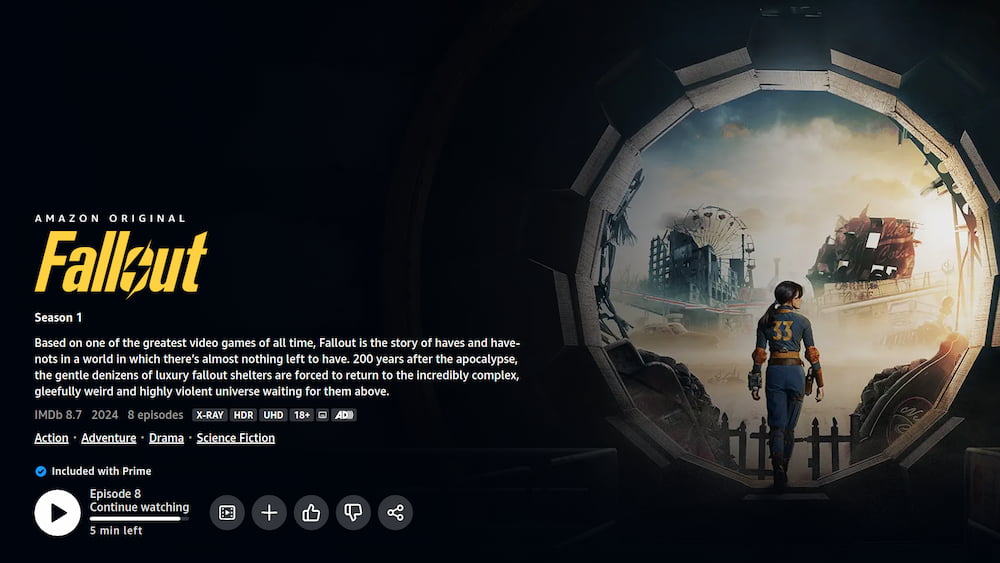What rocks, and what sucks about the Amazon’s Fallout TV series? To discuss that, I’ll start with an overview of the Fallout computer games, and take a broader look at art in general (briefly… I plan). 🙂
1. Where I’m coming from
I am a huge Fallout fan. If I had to pick one favourite computer game of all times, it would be Fallout 2 (with the original Fallout – 1 – closely behind).
I played my first Fallout game in the past century (yes, I am as old as it sounds – LOL). Most of my friends & family aren’t much into gaming, so I don’t talk about it – but apparently I did mention it enough for my better half to surprise me with this 40th birthday cake (and party):
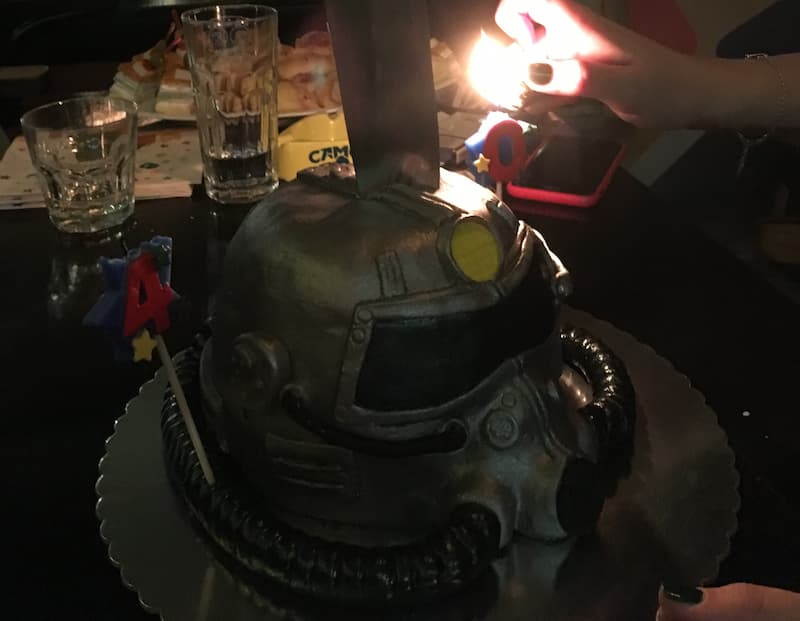
So, the “franchise” (hate that word) holds a special place in my heart, and that’s why I felt the need to write about the TV series I was both looking forward to, and being afraid of (after having seen what Amazon did with “The Rings of Power” series).
2. Defining the retro-futurism universe
I’ll first briefly discuss the games, since the TV series is a screen adaptation of the games.
The Fallout game came out in 1997. It is set in a retro-futurism world. That’s quite important and we’ll get back to it. What is retro-futurism?
Did you read Jules Verne’s 20,000 Leagues Under the Sea? The crazy Frenchman imagined submarines long before they existed – as one could imagine it in the 19th century. Fast-forward, if you look at the 1984 (first, “original”) Blade Runner film, you will see how the folks in the 80s (XX century) imagined the year 2019 – with no camera smartphones in everyone’s pocket:
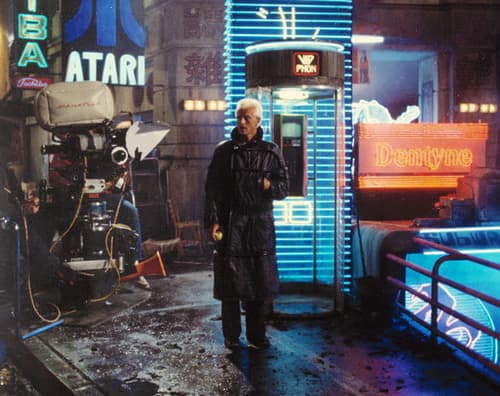
Sure, they also have flying cars, which are still not a reality (in 2024), humanoid robots, and colonised planets, but no one had imagined an iPhone in 1984!
Likewise, Fallout takes place in the retro-future of 1950. The game’s creators made a world in 2077 in a way that 1950s people would have imagined it. At that time:
- Electronics were not nearly as promising and highly developed (no laptops, smartphones etc.).
- Nuclear destruction and cold war were scary and looked quite imminent.
- Nuclear fusion power was promising and looked to be “just around the corner” after the nuclear fission gets developed.
In theory, nuclear fusion power, unlike the fission, doesn’t create nuclear waste, and promises immense amounts of power.
That is the kind of world that was imagined for 2077. Then, and this is also important, a nuclear world war breaks out and the whole civilisation gets reduced to rubble.
The first Fallout game takes place in 2161 – a century after “the bombs fell.” What we are left with as Fallout players is the savage, lawless wasteland, with tribal communities, and some relics left over from the “glorious” 2077 – that most in-game characters have no idea about – how they work, how they were made etc (in a similar way that you and I can’t build a computer from scratch without using any books or the Internet – only we have the advantage of knowing what it is and what it does).
Again:
Fallout is not 1950. It is the 2077 as the 1950s folks could imagine it… only in complete rubble – a complete civilization reset… apart from the vaults.
3. The vaults

In the Fallout universe, people in 2077 had built special, big bomb shelters that were designed to house people for centuries in case of a nuclear war, so they can emerge when the surface clears, with health, sanity, and knowledge in-tact and rebuild the civilization (there are some catches with this, but I’ll avoid spoilers).
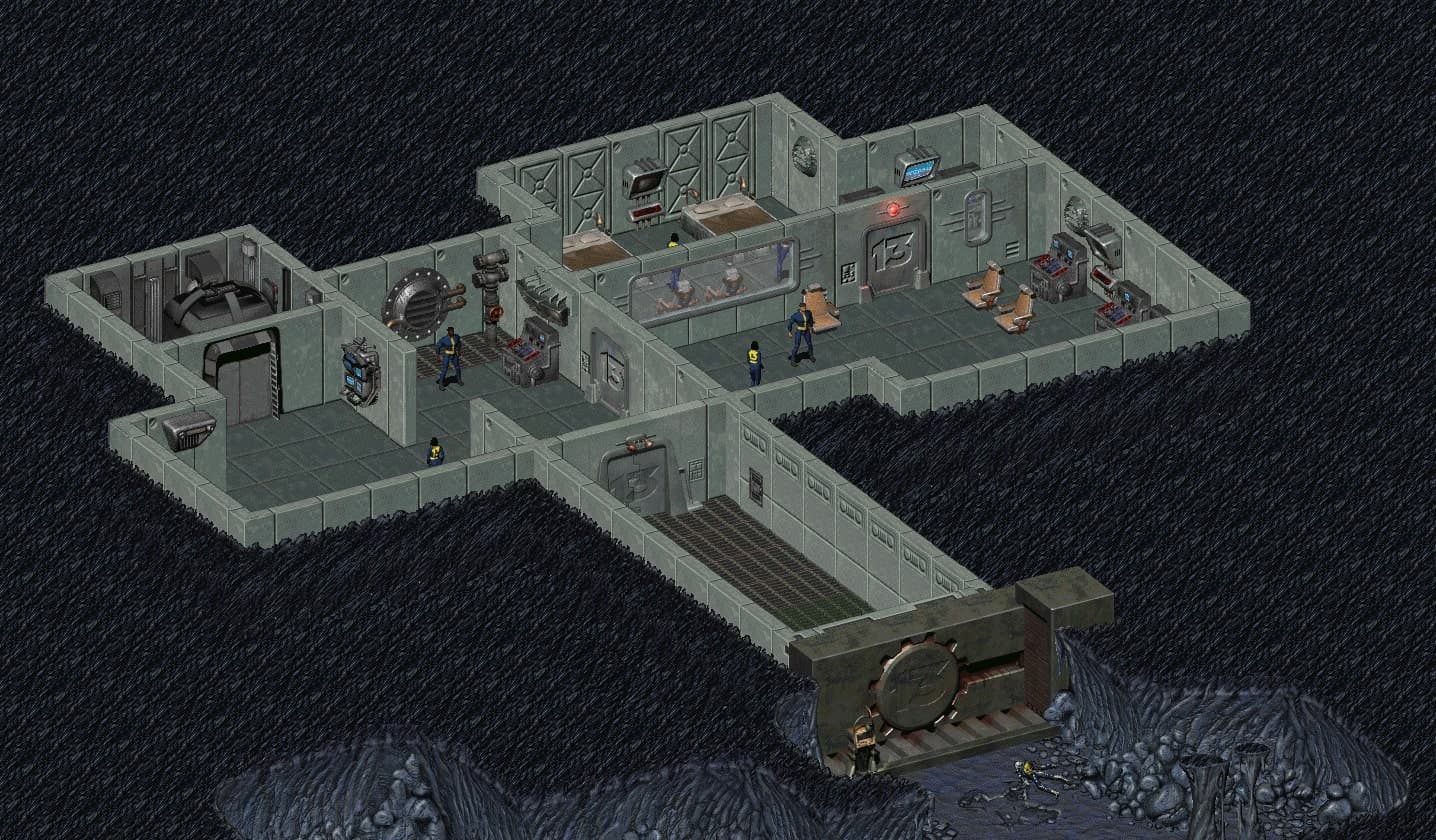
People from the vaults (referred to as “vault-dwellers”) were sheltered from the radiation and the lawlessness of the outside world, behind the heavy, sealed vault doors.
4. Fallout (1) game
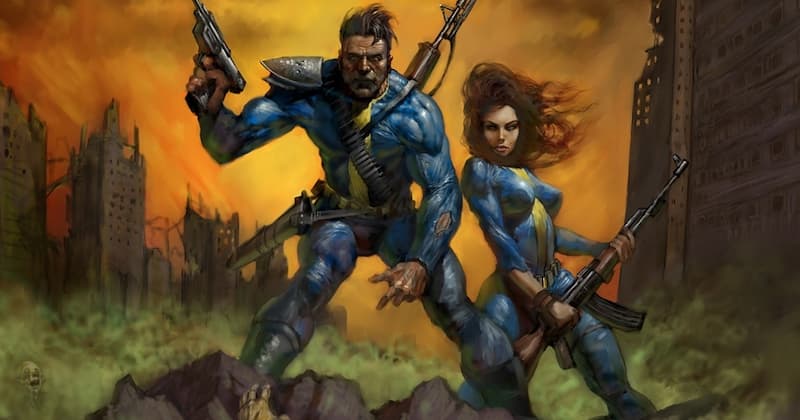
Published in 1997, Fallout 1 takes place in 2161 – almost a 100 years after “the bombs fell” (nuclear world war took place in 2077 in the game’s retro-futurism timeline).
In the original Fallout game, you are chosen (“volunteer”) to emerge from the vault to find a functioning water-purifier chip, as the one in your vault stopped working, and you only have some ~ 150 days of clean water supply left.
That is the plot that pushes you into exploring the irradiated wasteland outside.
The world is cruel, grim, no black-white morality whatsoever. As a player, you don’t know how dangerous the creatures and people (and factions) you meet are. You need to figure it out on your own, and the game doesn’t force you into playing a good guy, or killing and stealing.
It gives you absolute freedom of movement, but you get killed if you don’t ask for help and direction/advice from the NPCs, as the entire world is very hostile. Most places you go to look like what tabula-rasa people could make after a century of trying to survive – stocking old cars as fences around towns and similar improvisations.
You can build your character as you prefer, see it grow in strength (as you gather resources and equipment) and affect the world around you in a meaningful, impactful way!
The story, the characters – it is all beautifully written and is quite immersing – makes you feel vulnerable in a hostile world, with some tough ethical choices (that you are free to choose without limits – but not without consequences of each).
I will avoid any spoilers, and yes, the interface is a bit clunky compared to the best game designs today – not that there aren’t any new games that do a worse job of inventory and actions.
5. Fallout 2

Published in 1998 (a year after the first game), Fallout 2 takes place in 2241 – some 80 years after the first game.
You are the descendant of the player from the first game (I will avoid any spoilers), and must find a way to help your village survive.
The game is technically polished compared to the first one – I’d say it’s quite good even for the modern standards. Even more importantly, the characters, story, freedom you have to move and make choices – it’s as good if not better: you can be a slaver, kill children and do horrible stuff if you decide to play that way, and the game won’t punish you for it (and not all the people will either – a lot like in real life).
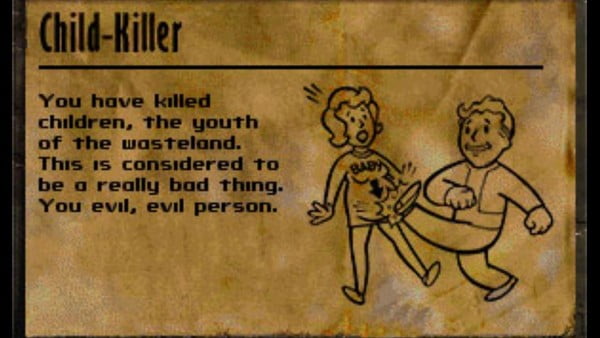
While the original game was a bit grim (fitting to the plot and the setting), Fallout 2 throws in some Monty Python style humour (dark humour, absurdity, breaking the 4th wall on occasions etc.), and has many pop-culture references (some, though not all, of which are now too old for many young players to get).
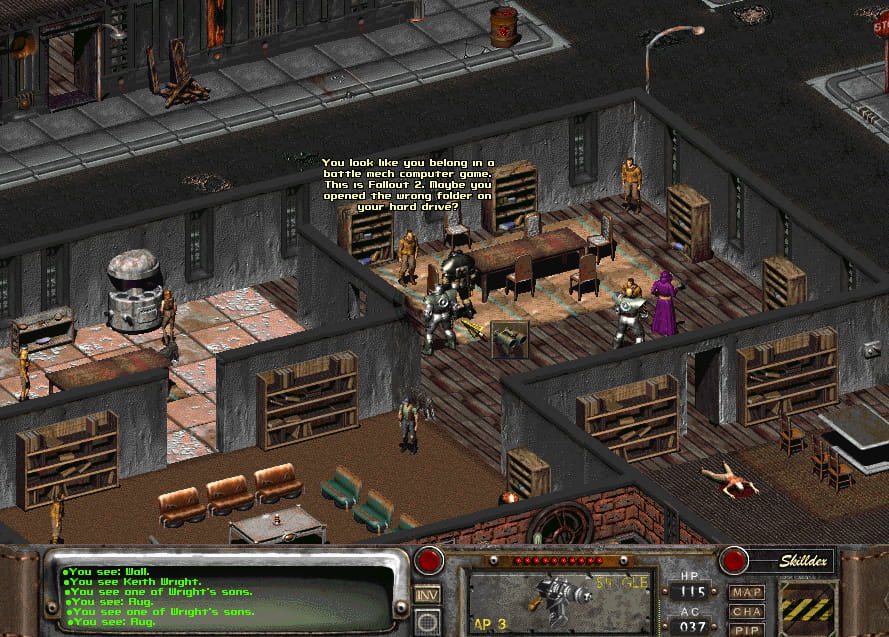
The humour is high quality and moderately served so it doesn’t break immersion (my friends’ and me live RPG sessions were definitely a lot “worse” in that account).
The world is bigger, and the game offers more different places to explore, has a great plot, and some surprises compared to the first part.
In the first two games, combat is turn-based (tactical), with action points to use for movement or actions. Hits and kills are designed to look and feel both gory and somehow satisfying – a powerful weapon will punch holes or destroy parts of even the very powerful enemies.
To me, this is the best, favourite game of all times (Fallout 1, and Wasteland 2 and 3 are close – but I won’t get into Wasteland universe now…).
6. Bethesda – Fallout 3
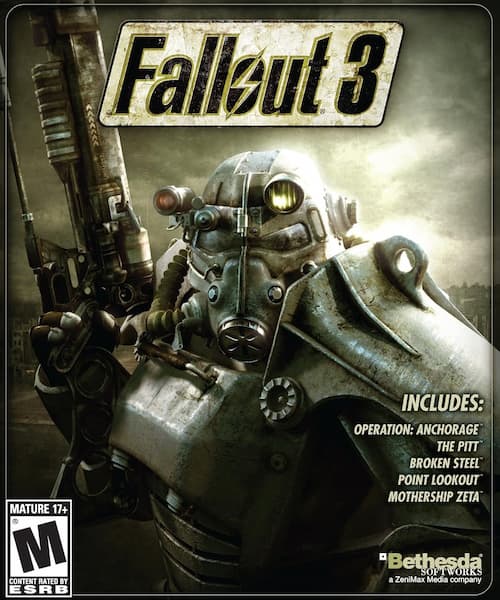
After a sad story with the developing studio, and a few poor spinoffs (Fallout Tactics was so-so, OK-ish for the hard-core 1 & 2 fans I guess), and a long draught, Bethesda acquired the rights to the “Fallout franchise.”
In 2008, they published the Fallout 3, which takes place in 2277 (36 years after the Fallout 2 timeline, and exactly 200 years after “the bombs fell”), on a completely different part of Earth (moved to Washington, from California).
This was a game I was really looking forward to – only to get a bit disappointed. It wasn’t a bad game, but it wasn’t really Fallout. Let me explain.
The gameplay changed from an isometric 2D view, to a 1st person shooter 3D view (you can set the camera to sit a bit behind the player if you like). But, they made some bigger changes to the world, and the story. What kind of changes?
Let me use an analogy. Imagine the corporate Bethesda folks looking at the Mona Lisa painting, and thinking:
“Hmm, that sells well, but it looks like someone took a brush and smeared oily paint on canvas. Why don’t we make it 100% photorealistic? While we’re at it, that facial expression is unnerving. Let’s make her face serious (and we could sell a sequel in which she smiles). We should also make here look more attractive – let’s hire a famous Hollywood actress for the model. Yup – perfect!”
High-quality art takes some effort from the spectator in order for them to enjoy it. Yes, the beauty is in the eye of the beholder, but apart from that worn-out statement, you need to concentrate, dive in, for the top-class art to move you, get you to think, feel, introspect, imagine… If you take all that away, you get cheap blockbuster films, McDonald’s cuisine, and, well, many modern games.
Now, back to the Fallout 3 directly:
They set it in the 1950s – completely missing the retro-futurism part!
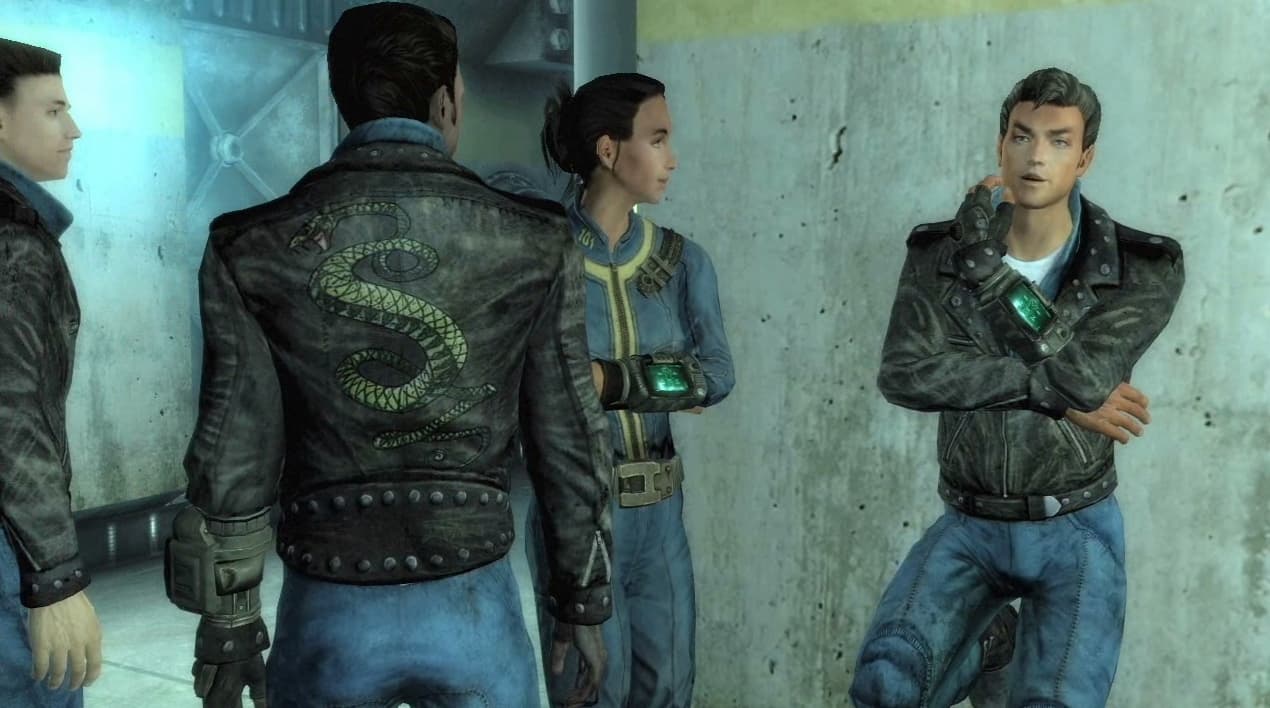
Written and built by the guys who just glanced at the original two games – and built something that sells well and fast. Just as Taylor Swift sells a lot better than Beethoven. It’s the spirit of the times – shorter attention spans, more spectacular, less philosophical stuff.
Characters, plot, freedom – it’s all gone. You feel like you are on an exciting roller coaster – safely fastened belt, tucked in… exciting, but 100% safe – while the first two games put you on a motorbike… and let you crash and burn if you push it too far!

Digression:
Fallouts 1 and 2 let you shoot kids if you decide to, but you then carry the shameful child-killer mark and some characters will hate you for it. If you can’t do any bad, you are not really good or heroic. Heroism is about being scared and doing what’s right despite being scared. Having the means and determination to do horrible stuff, and deciding to not do them even if you could profit from them. That’s a choice. That’s real character, bravery and goodness. Fallout 3 simply forbids you from having a choice to be good (or evil). Oh… almost forgot: you can destroy a whole town in Fallout 3 if you like, nuke it… talk about hypocrisy.
The world is full of rubble. Even places where people live and work are left in utter mess. As if people are not capable of removing debris they would keep tripping over in their daily lives.
Having said all that, Fallout 3 is a good game. I played it and enjoyed it. It’s just that it isn’t brilliant, like the first two games were. It is similar with all the other, newer Fallout games, with one noteworthy exception I’ll briefly discuss now:
7. Fallout: New Vegas
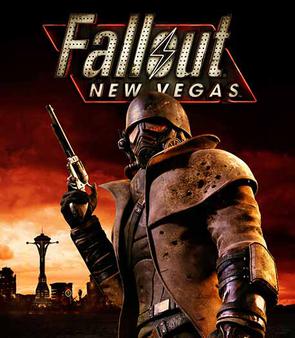
Published in 2010, the game takes place in 2281, four years after the Fallout 3 game’s timeline.
The New Vegas was published by Bethesda, but built by Obsidian – a studio formed by many former original Fallout developers.
It uses the same engine, so doesn’t have many differences in technical terms. The story, on the other hand… let me just say that it starts with you getting shot in the head and left for dead in a shallow grave. Yes – how is that for a start? 🙂
The world also looks more believable even though the same graphics engine is used. People don’t just leave rubble lying on the floor and on chairs and tables of places where they live and work.
The game is generally not as good as the original two Fallout games, but it gets close on occasions – also giving you many difficult ethical choices (with no clear-cut positive outcome, as each choice has its pros and cons). They also got the retro-futurism universe right. A lot of “pre-war” stuff is found, but used as people from the rubbles of civilization would patch and use (in a similar way that you could use a laptop screen as a mirror if there were no electricity or intact mirrors to find).
In terms of quality and the story, I would say that New Vegas is somewhere in between Fallouts 2 and 3. Not as good as the 2, but not nearly as crappy as the 3 (and the latter editions).
What about the TV series?
8. Fallout TV series (by Amazon)
What did Amazon do with the Fallout story and universe? Let’s dive into that, without spoilers.
My first impression was that it is very slow. I saw that it has 8 one-hour episodes, and it looked as if they tried to make the show fit into 8 hours, without having that much to say. That is a common problem with modern series. Instead of using the series format to tell longer, more complexed and nuanced stories, develop characters (and even use running jokes if appropriate), they just drag out what could be a mini-series (if not a single film).
The world building is pretty good. Vaults, and the wasteland seem believable.
The main character, Lucy MacLean is a believable strong, brave woman – not the nonsense that Hollywood has been thowing at us lately (and what Amazon did with Galadriel in their “Rings of Power”). Lucy has her downsides, she makes mistakes – and she grows and learns from that experience.
Other characters are pretty good too. Acting is also quite good – no complaints there.
As for the story, well. Again – pacing is slow, but they tried to make the most out of every action scene (for spectacle and more run-time filled). The action scenes are good, and true to the in-game experience of combat. I love how they depicted the use of stimpacks and the over-the-top weapon damage effects.
Overall, the story and the plot feel a lot closer to Fallout 3 than to the original two games. I expected that.
A glaringly illogical fact is that there are no children!?! In Fallout 3 you couldn’t kill ’em, in the TV show you don’t even see ’em (apart from a few flashback scenes).
I suppose this censorship policy helps reduce the US school shooting incidents by 10% or something…
The plot feels a bit pushed. For example, they added (invented) a “catch” regarding ghoul behaviour in order to make the plot easier to keep moving as they planned. Likewise, people keep coming across each other in the vast wasteland whenever that is convenient for the plot. I didn’t count how many times that happens, but the feeling I got was: “oohhh, COME ON!?!” There are other ways to do keep the plot going, but that requires high-quality writers.
The story does involve corporate greed (and warmongering), but, like most modern shows/books/games, it paints it as a few corporate bad apples ruining it for everyone, as if that’s not how capitalism always inevitably works in the long run.
Another annoying moment is a character that seems to know a lot. He starts talking and explaining stuff to Lucy, without being really asked. However, just as he had started, he stops – without explaining the whole story, the world. This is a crappy way to tease the audience (at least those with any brains, IMO). The simplest better way that I can think of right away is for the main character to find fragments of notes, data etc.
OK, with the bad stuff out of the way, let’s see why I like and recommend the series, despite its flaws:
I’ve watched the series with my better half. All she knew about Fallout was that it’s my favourite game (she’s not a gamer). So, unlike me, she had zero expectations and agreed to watch only because of how excited about it I was. And she loved it! Unlike the Witcher screen adaptation, Fallout explains it all and builds the world nicely, so you can get the grasp of all the characters and factions. She had next to no questions about who’s who and what’s what, what’s with the vaults, radiation etc. (unlike with Witcher, to call it out again). Apparently, the TV show is a great introduction to the Fallout universe.
The scenery and effects are very good, they get you into the post-apocalyptic world, but the show doesn’t feel too depressing. Actors, acting, and dialogues are good.
Overall it is enjoyable to watch, I liked it despite its flaws.
If you want more details, with some spoilers, read on.
9. SPOILERS – and further discussion
I’ll do my best to keep any spoilers at minimum – but can’t make any promises.
9.1. The main characters
I won’t go into every single character. There are many, and practically all are pretty well written. These are just some of the most notable:
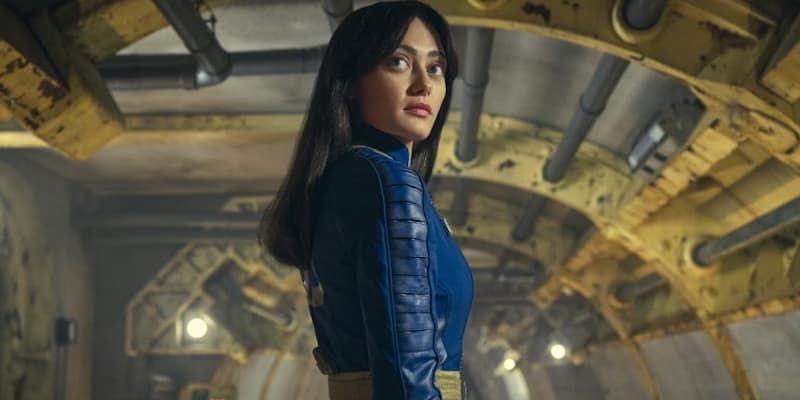
The main character (Lucy MacLean) introduction is brilliant. Looks deliberately like the in-game character building, but without making it look artificial and spoiling to any non-gamers. She trains and is good at some stuff and is less good with other stuff. She has no magic superpowers and is not supersmart. When you see her doing things and figuring stuff out later on in the series, it is based on her training and experience, as shown in the series.
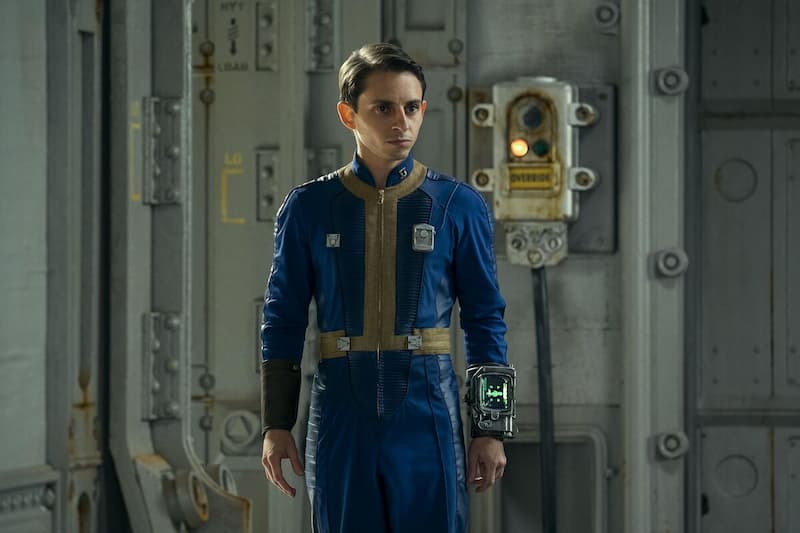
Lucy’s brother (Norm MacLean) is imperfect, cynical, and shows fear at the start of the show, but isn’t a weak coward. He’s more nuanced than that (avoiding the modern Hollywood cliche when the main character is a strong, brave woman), and also grows based on his experience.
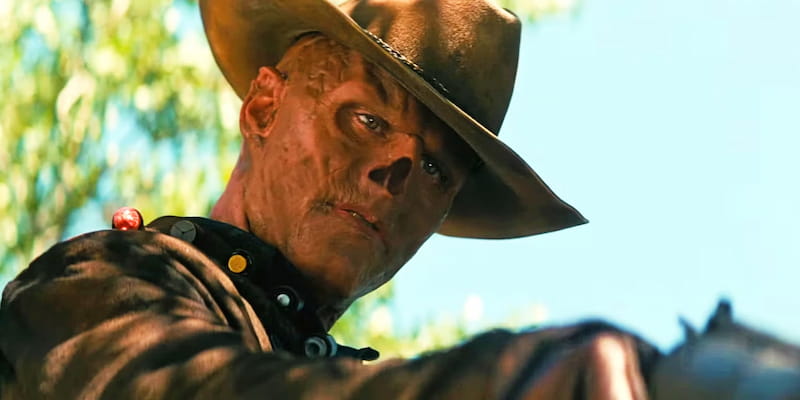
The Ghoul, aka Cooper Howard is depicted in a Sergio Leone spaghetti-western like style – with no clear-cut 100% good/bad ethics. His memory flashbacks are used to tell the story of how the vaults and the whole nuclear war stuff happened.

Lee Moldaver is another not 100% black/white character that has a complex history and story, with some tough choices of her own to make. Another example of how you can write a strong, brave woman character well.
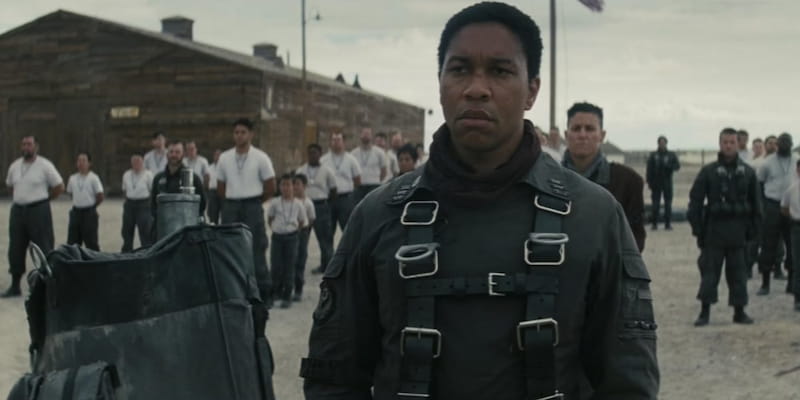
Maximus gets a lot of screen time and I think the actor did very well to portray the character as it was written (like most other actors in the series for that matter). I could relate to this character on several levels, but I won’t bother you with my childhood traumas. 🙂 Maximus portrays how I often play Fallout games: trying to do good, make a change for the better, but when faced with some tough choices and dangerous situations, it gets tough to stay brave and righteous – and ethical choices are often blurry (never just black-and-white).
Now, I could talk for hours about each character, but I will cut it here. Yes, I know I “missed” some important, major characters with a lot of screen time. Maybe I’ll make a separate series if more than ten people see this and are interested. 🙂
9.2. Vaults, wasteland, and “towns”
“Towns” go under quotation marks because by that term I mean every stationary encampment.
The depiction is great. This is an imaginary world, from the games, but there still is a thing called artistic freedom and interpretation. Amazon folks did a pretty good job with depicting the ruined wasteland, forrests, towns, encampments, and the famous underground vaults.
Pictures speak louder than words, and here are some screenshots (with a bare minimum of spoilers) – click on an image to enlarge it:
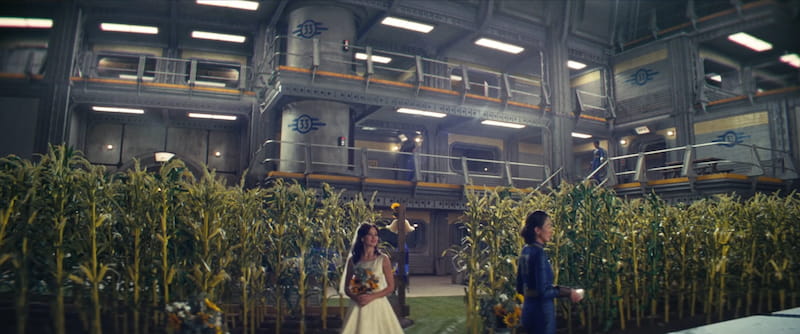
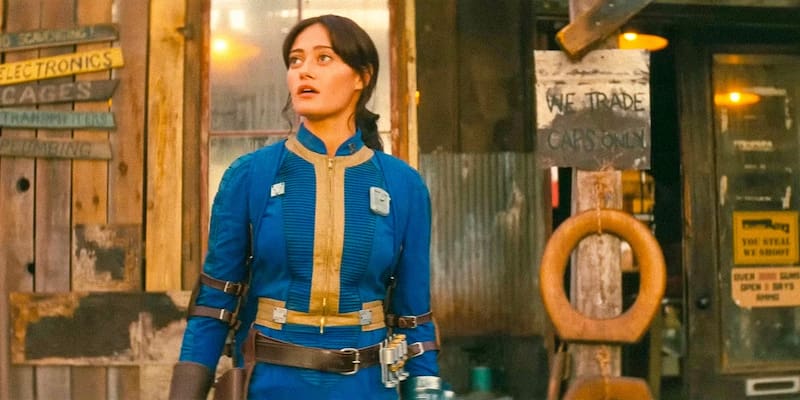

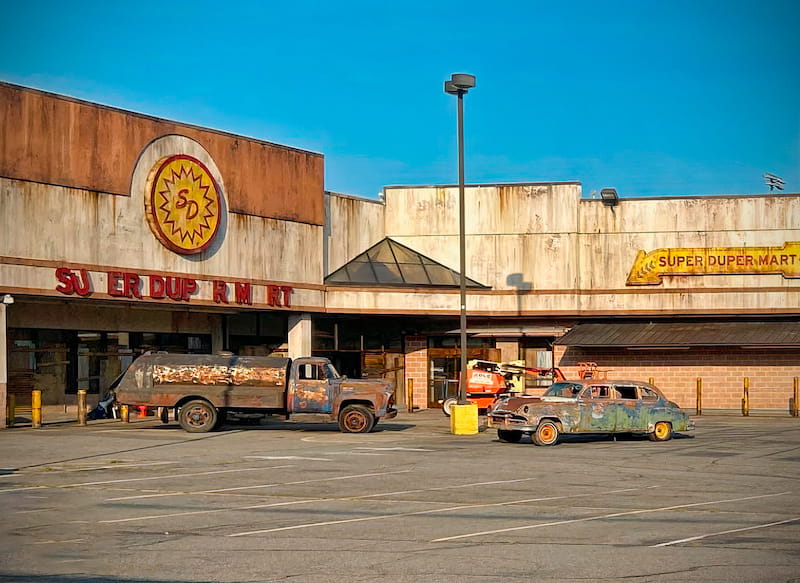
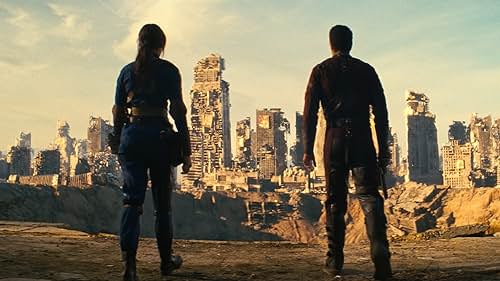
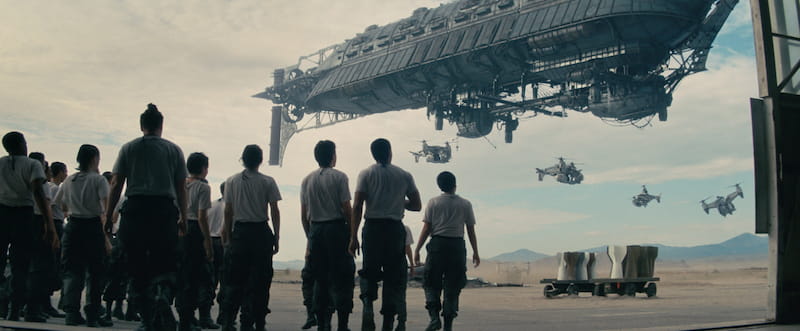
9.3. Makeup, costumes and effects
Top notch. They seem to have used CGI along with some costumes so it all looks very realistic …well, at least in a retro-future imaginary game adaptation sort of way… 🙂
Shobby clothes, vault suits, and the famous power armour are all awesomely depicted.
Faces of sheltered vault dwellers and of the folks living in the wasteland look convincing. The same goes for masks, deformations etc. Great job by the tech. & makeup staff.
9.4. The future – Season 2?
As expected, following the TV series release, Bethesda’s Fallout game sales have surged. This is a cash-cow, and you can bet your life that Amazon & Bethesda will milk it as much as they can.
They will make sequels by any means, even if they can’t think of a coherent story to tell. It may be good, it may suck – but it will come either way.
Judging by the amount of special effects, production quality etc, I would not expect to see a sequel for at least another year. In the meantime, we will be showered with Fallout game sales, promotions, perhaps another sequel being published (Fallout 5?), and a lot of TV show teasers and hype-building (modern marketing 101, basically).
I expect “The House Always Wins” Fallout New Vegas game ending to be included in the timeline for the TV show’s sequel – I won’t include any spoilers, but by the end of the Season 1 you will see why I think so.
10. Conclusion
Fallout games (including the less-than-awesome Bethesda published ones) and the TV series are pretty good. Worth experiencing.
At the cost of sounding repetitive, if you can see the beauty and essence past the technical imperfections, I would heartily recommend playing Fallout 1 and 2 (GOG.com sells them for a few bucks), and Fallout: New Vegas.
The TV show is also worth watching – at least the Season 1 that is available now. There is a 0.1% chance they won’t ruin it and turn it into Game of Thrones (or Walking Dead) over the following years. We shall see.
11. A (YouTube?) video review
I’ve also made a video review with some (non-spoiler) scene shorts played. Unfortunately, Amazon have blocked the video because of “copyright claims.” I have disputed the claims under the “fair use” policy – and I hope to see it get sorted out (otherwise, no YouTube review channel could post any videos). That will take some time though.
Update – fortunately, my video got cleared! 🙂
Last updated:
Originally published:

